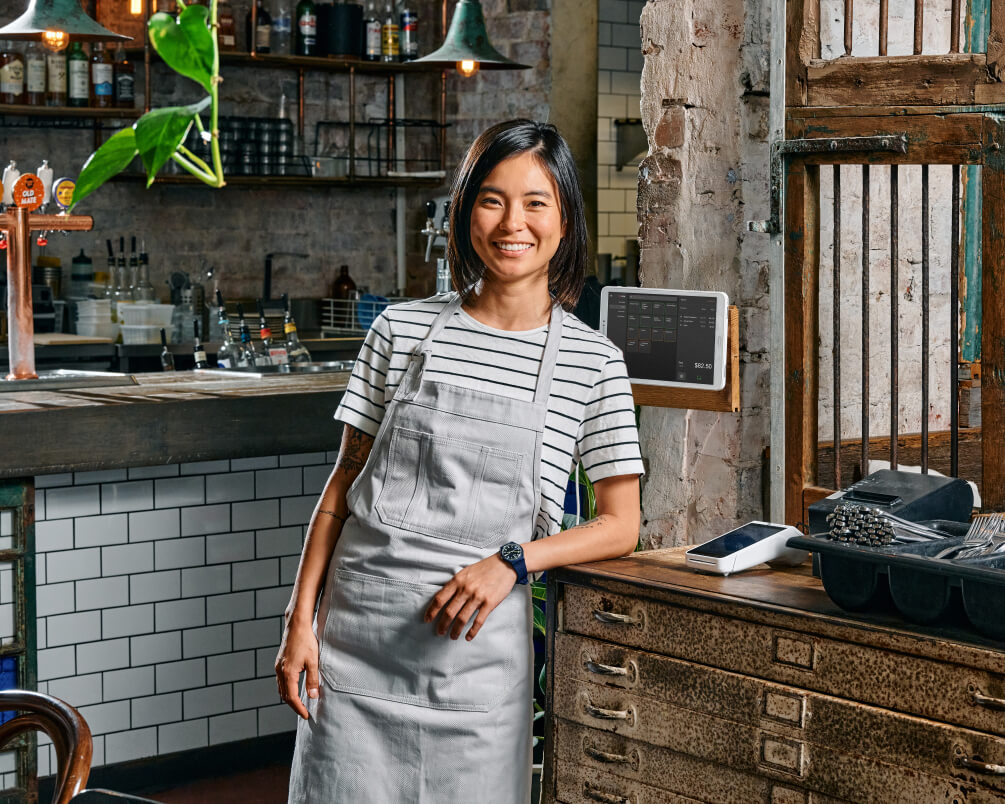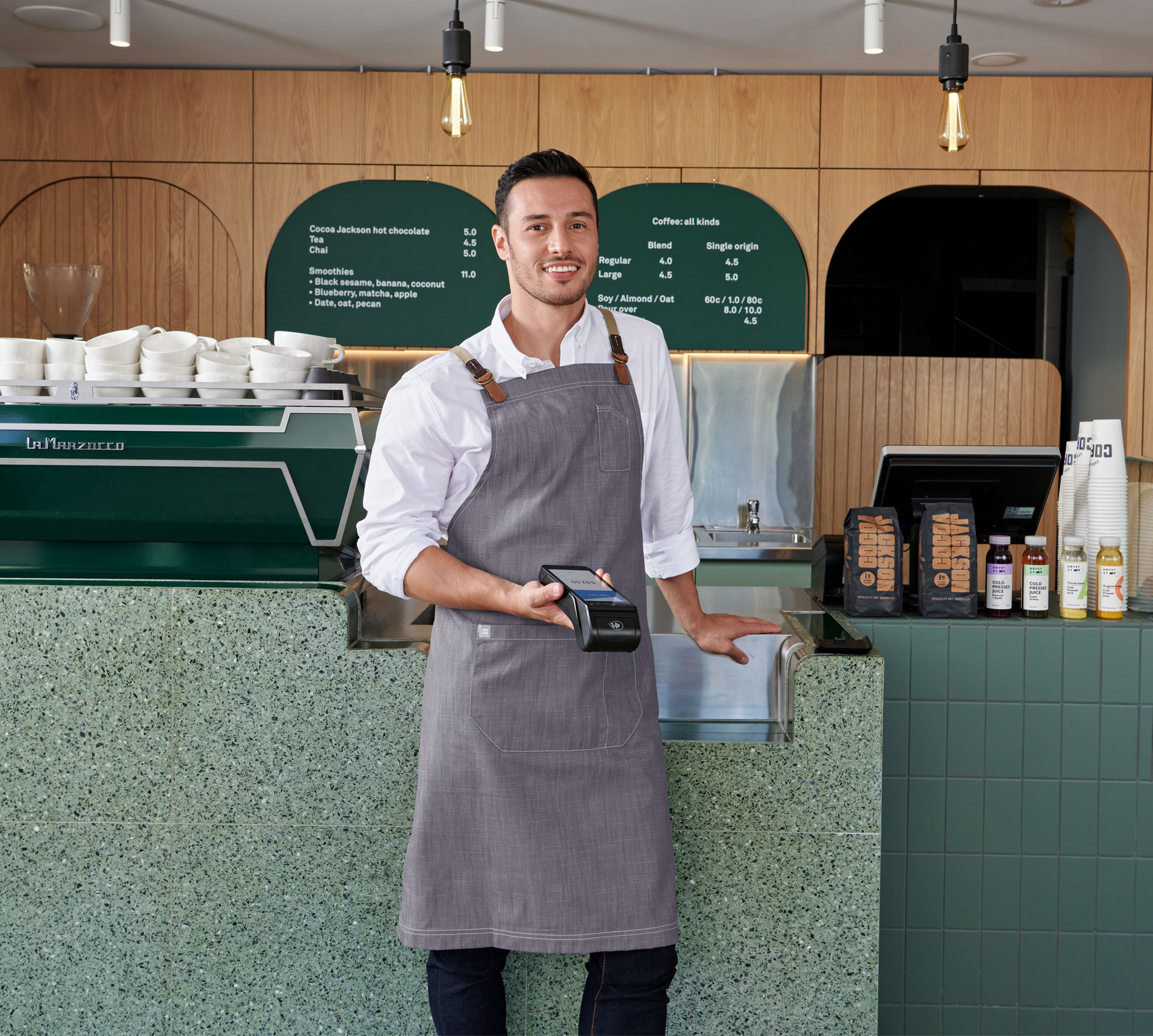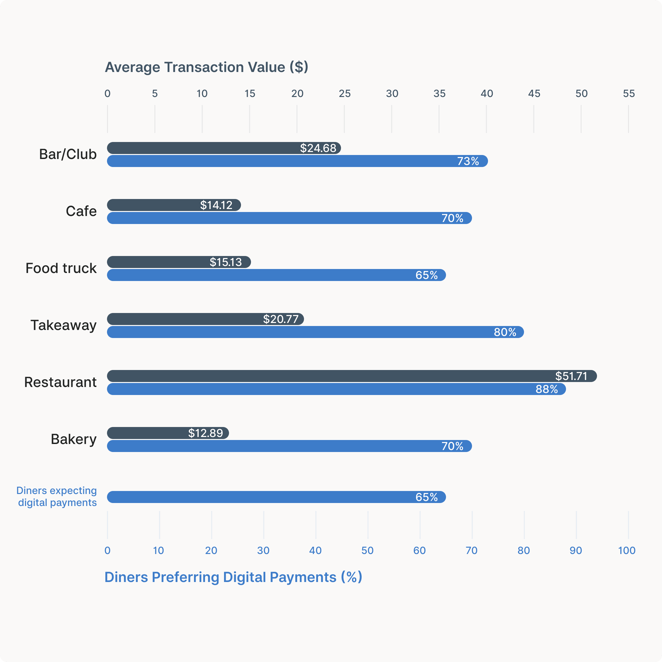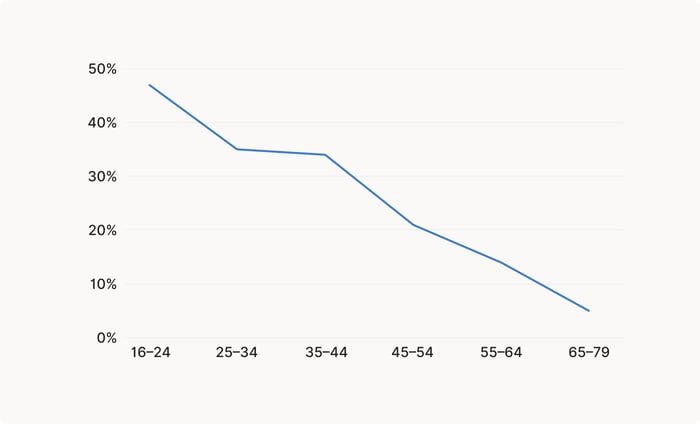Introducing Zeller for Startups.
Don’t waste time assembling disparate tools or waiting in line at a bank. Zeller for Startups is an all-in-one financial solution for founders, by founders.

Don’t waste time assembling disparate tools or waiting in line at a bank. Zeller for Startups is an all-in-one financial solution for founders, by founders.

Speak to our expert team about your in-store payments, and we’ll personalise a solution to your business and budget.

Enjoy a free, built-in POS system with the new Zeller Terminal 2. Order today with free express shipping nationally.

Starting a new business? Enjoy a free, built-in POS system with the new Zeller Terminal 2.
Dining out is an experience Australians hold dear to their heart — the pandemic hasn’t changed that. Both a popular pastime and a beloved convenience, dining out (or taking away) is something most Australians do at least once a month.
Importantly, diners’ purse strings are tighter these days; 49% of Australians tell us the pandemic has negatively impacted their household finances. It follows that diners will be more selective with when, where, and how they choose to spend their money. Regardless of the style of dining you offer, and whether your operation is established or new, the quickest path to recovery is adapting your offering to meet diners’ needs. So, what do diners want?
It should come as no surprise that today’s diners take a venue’s COVID-safety precautions into consideration when choosing where to dine, or order takeaway from. The question is, to what extent?
Zeller research has uncovered a sizable shift in what diners deem most important, and determined that COVID-safety is key to recovery. In fact, the policies and procedures a venue puts in place to protect its customers are more important to diners than many other elements of the dining experience — including the price of the meal, and the venue’s location.
 Percentage (%) of Australian diners that find the above venue factors important when choosing a venue to eat at, or order takeaway from.
Percentage (%) of Australian diners that find the above venue factors important when choosing a venue to eat at, or order takeaway from.
For merchants, this should provide a level of comfort; the extra effort required to reopen doors safely and enforce COVID-safe policies and procedures will pay off. Diners value those efforts, and consider a venue’s COVID-safety measures more important than the price of the food they eat.
In the last 18 months, foot traffic has been stalled by various public health orders. Naturally, the majority of Australians are dining out less frequently than they were prior to the pandemic.
The pandemic hasn’t stifled diners’ hunger, but it has impacted the way they choose where to eat. Zeller research shows 67% of diners are planning to spend their money close to home, and support local eateries. With eased restrictions, merchants in Victoria and New South Wales are especially likely to benefit from an increase in local love. However, it won’t be evenly spread.
Across Victoria and New South Wales, hospitality venues based in metro areas are most likely to benefit. In metro areas, 25% of diners are planning on dining locally more frequently than prior to the pandemic — compared to just 14% of regional diners.
Cash use has been in steep decline for a number of years, yet the outbreak of COVID-19 is likely the final nail in the coffin. Customers are unlikely to want to handle cash; it can carry viruses and bacteria. The same considerations apply to staff and suppliers, who no doubt want to pay — and be paid — digitally.

Zeller research shows 76% of Australian diners reach for their card or device over cash, meaning that having the EFTPOS tools to accept cashless payments quickly and securely is essential. The generational shift to digital wallets underlines this necessity. A third of young diners — those aged between 16 and 34 — reach for their smartphone or wearable device, regardless of whether they’re buying from a food truck or cafe, or dining at a restaurant.
It’s imperative that your venue is able to accept payment via Apple Pay, Google Pay and Samsung Pay with a next-generation EFTPOS terminal, and that staff are comfortable processing such transactions. At Zeller, our expert development team monitors payment trends and then builds functionality that allows your business to accept these modern payment methods.
Understanding what diners want from your hospitality business is the first step to taking advantage of opportunities for growth. The merchants who understand these shifts are best positioned to implement the changes necessary to grow their business in this new landscape.

Our local Zeller Sales team is here to help your venue succeed. Leave your contact details and we’ll be in touch soon.
Zeller’s research uncovered seven specific actions merchants can take to meet the above needs, cut costs and speed up business recovery by attracting more diners, upping their spend, improving operational efficiency, and more. Keep reading to discover how to:
Capacity restrictions were the catalyst for many venues to introduce bookings, yet the easing of these restrictions doesn’t mean a return to the old ways is necessary — or ideal. Any merchants considering going back to walk-in only service should consider what their customer wants.
Our research shows 82% of Australian diners would book in advance. These days, the majority of diners want certainty — and they don't like to wait. Merchants can benefit from this shift by encouraging bookings, and enjoying the operational efficiencies that flow from a full run-sheet.
For bookings to be an effective growth strategy, the right number of tables must be kept aside for walk-ins and no-shows must be discouraged.
Striking a healthy balance between reservations and walk-ins is no easy task. Should every table be available for booking? Or is it best to have a split — perhaps a 60/40 mix? Will regular customers and walk-ins be able to grab a spot last-minute?
With capacity restrictions a part of normal life, the overall majority of diners have become accustomed to the requirement to book ahead in order to secure a spot. Just 18% of metro diners say they will walk into a venue without booking ahead. In regional areas, that figure drops to 16%.
That means an inner-city restaurant with capacity for 40 diners could allow 32 seats to be booked in advance, and the remaining 8 seats would likely be filled with walk-ins. A regional diner may set aside fewer tables for walk-ins.
However, the demographics of a venue’s average customer also has an impact. The best formula for your venue will take into account the customers’ preferences.
Percentage (%) of Australian diners that are likely to walk-in vs. book online, by age group.
25% of Australian diners between the ages of 65 and 79 say they prefer not to book in advance, whereas just 13% of diners below 34 would consider walking in without a booking. This means bars and restaurants frequented by young people are more likely to be booked in advance, compared to a local RSL club, for example. It follows that merchants with younger clientele could comfortably open more seats for bookings.
No-shows have always been a pervasive pest in the hospitality industry. A 2017 study found no-shows were costing the Australian restaurant industry $75 million per year. Add capacity restrictions, and the impact of a no-show stings all the more.
Yet 82% of diners say booking requirements don’t deter them. Merchants could consider enforcing requirements — from a soft approach (such as sending a reminder text 24 hours prior), through to charging a booking deposit or cancellation fee — to discourage no-shows.
Our research shows that, for the majority of diners, the limit for a non-refundable deposit is $15 per person — so take that into consideration when setting your price. Interestingly to note, our research shows that young people (diners between the ages of 16 and 35) are the happiest to pay a deposit. Bars and lounges might find their clientele are less opposed to the idea of a non-refundable booking.
The simplest way to accept a deposit is over the phone, by processing a manually-entered card transaction through Zeller Terminal.
COVID-safety is a key concern for diners, and that extends to the payment experience. Offering contactless transactions is critical. Relying on a portable EFTPOS machine significantly reduces the possibility of transmitting the virus from one person to another, and allows staff to accept contactless payment tableside — meaning less customer movement on the floor.
“Taking payment at the diner’s table helps avoid having people standing around and moving through the restaurant. It’s definitely important [for COVID-safety],” says Dylan McMahon, Winemaker at Seville Estate.
Two thirds of diners say they always prefer to use a digital form of payment over cash, regardless of whether they’re buying a bite from a food truck, a bakery pie, or a pint from the bar.
Even more interesting is the correlation between the average transaction value and diners’ preference to pay digitally. By crunching the numbers on hundreds of thousands of transactions processed by Zeller, we can see that the more expensive the meal, the more like a diner is to reach for their card or digital wallet.
For example, 65% of food truck customers will typically reach for their card or digital wallet. On the other hand, 88% of high-end, sit-down restaurant diners prefer to pay digitally — meaning an EFTPOS terminal should always be on hand, ready for when a diner gives the nod.

If that’s not enough of a reason, there’s the nine minutes your staff will save with every transaction and the improved customer experience to consider. All the extra steps involved with cash transactions add almost ten minutes of service per table. Extrapolated over a full day of service, and that’s hours saved.
Discover more about the benefits of portal EFTPOS technology on the Zeller Business Blog.
Excess inventory means food waste and spoilage, as well as wasted dollars.
There are a number of ways merchants can reduce their level of excess inventory, depending on the style of venue. A bar, for example, is unlikely to implement a cost-savvy set menu — such things require a great deal of attention and planning to get the balance just right. However, there is at least one way for every type of hospitality merchant to reduce their venue’s food wastage.
Australians love a deal; Zeller research shows it’s the best way to get more diners eating at, or ordering from, your venue. 77% of diners would dine out more if offered perks or benefits — the most popular of which is weekly food and drink specials, appealing to diners more than takeaway specials, group deals, and loyalty programs.
 Weekly specials are a good way to broaden your venue’s appeal, and entice diners on a budget who might otherwise not have dined with you. Remember, the pandemic has negatively affected almost half of Australians’ back pockets. Another obvious benefit is that, in choosing your specials, you can focus on seasonal produce to keep your food costs low year-round. Ordering in bulk also spells savings.
Weekly specials are a good way to broaden your venue’s appeal, and entice diners on a budget who might otherwise not have dined with you. Remember, the pandemic has negatively affected almost half of Australians’ back pockets. Another obvious benefit is that, in choosing your specials, you can focus on seasonal produce to keep your food costs low year-round. Ordering in bulk also spells savings.
Specials can take a number of forms — which you choose depends on your growth goals. You might choose to offer midweek specials on evenings where foot traffic is low. Or, you offer daily discounts outside the lunch or dinner rush.
A limited menu means more straightforward ordering, and fewer infrequently used ingredients — which tend to create food wastage. If very few customers order the fruit salad, for example, consider scratching it from the menu. Fresh fruit can go off quickly, and it is an unlikely ingredient in any other dish.
In considering which items to scratch from the menu, think about how long the ingredient lasts as well as any storage requirements. A piece of aged meat requires a considerable amount of space in a cold room or fridge, whereas a tub of gold leaf can perch on a shelf, for example. The meat is also likely to reach its use-by date quicker.
Set menus, once the remit of high end dining, have become commonplace in family-style restaurants. For diners, it’s a convenient way to dine with a large group. For merchants, it’s an opportunity to increase margins and better prepare the kitchen so less food is wasted.
Set menus make everything easier, from ordering ingredients, to preparing the kitchen, to ordering, and then transacting. By tactically selecting those dishes with a higher profit margin, a “Feed Menu” menu can reduce food wastage while upping customers’ spend.
To reduce contact with the customer even further, merchants can explore the possibility of digital receipts. 57% of diners say they would be happy without a paper receipt — meaning the majority of receipt paper is likely being wasted on customers who promptly put their receipt in the bin. Opting for a digital version is also an easy way to make your venue more sustainable.
Of course, the demographics of a venue’s customer base influences this figure. Zeller research shows a distinct correlation between a diners’ age, and their preference for paper vs digital receipt.

Percentage (%) of Australian diners that prefer digital receipts, by age group.
As younger generations appear, the trend will continue until paper receipts are a thing of the past. Most merchants could halve the recurring expense of receipt paper by offering diners a choice: a print receipt, email receipt or SMS receipt?
Of course, staff must have the ability to quickly change the receipt format via the EFTPOS terminal. With Zeller Terminal, it’s as simple as tapping Email, SMS or Print receipt.
Australians have a love affair with food. Zeller research shows that, prior to the pandemic, 77% of the population regularly dined out or had food delivered. In the recovery phase, it will be critical for merchants to win back regulars and attract new customers through strategic marketing.
The marketing strategy with the best return on investment will be the one tailored to the customer. Merchants must consider their average customer, and where that customer gets their information — including where to eat. A customer’s location and age both have a significant impact.
Overall, it is clear from the above that word of mouth is the most powerful form of marketing; 75% of Australian diners say they rely on it, regardless of age. Yet in 2021, word of mouth doesn’t strictly refer to a verbal recommendation. To your youngest diners, it extends to user-generated content, social media shares, public reviews, and the like.
Many diners are getting their recommendations on the web. In fact, 97% of people go online to find and research local businesses. As the hospitality industry enters the post-pandemic recovery phase, it will be critical for merchants to put their venues in the right (virtual) places. Read our blog for more ideas to help attract more diners through smart, localised marketing.
| 16 - 24 | 25 - 34 | 35 - 44 | 45 - 54 | 55 - 64 | 65 -79 | |
|---|---|---|---|---|---|---|
| Word of mouth (friends, family, co-workers etc.) | 65% | 68% | 70% | 83% | 88% | 82% |
| Social media | 47% | 51% | 44% | 29% | 24% | 13% |
| Traditional media (newspapers, magazines) | 23% | 21% | 23% | 19% | 23% | 30% |
| Food/lifestyle bloggers & influencers | 21% | 23% | 19% | 7% | 1% | 1% |
| When I pass by somewhere new & notice | 48% | 51% | 54% | 56% | 55% | 55% |
| Online publications | 22% | 30% | 20% | 14% | 9% | 2% |
Percentage (%) of Australian diners on how they find out about new places to dine or drink at, by age group.
57% of diners in metropolitan areas say they discover restaurants, bars, cafes and more through social media and food bloggers’ or influencers’ advice. For merchants, this demonstrates the importance of having an “Instagrammable” offering and engaging in the local online community. Some Zeller merchants have also found TikTok highly beneficial in growing a customer base during lockdown, despite foot traffic slowing.
On the flipside, the majority of regional diners (59%) only discover a new venue when they see it in person — meaning the success of any marketing strategy hinges on foot traffic at the venue’s location.
| Metro | Regional | |
|---|---|---|
| Word of mouth (friends, family, co-workers etc.) | 73% | 78% |
| Social media | 41% | 29% |
| Traditional media (newspapers, magazines) | 23% | 23% |
| Food/lifestyle bloggers & influencers | 16% | 8% |
| When I pass by somewhere new & notice | 50% | 59% |
| Online publications | 22% | 9% |
Percentage (%) of Australian diners on how they find out about new places to dine or drink at, by metro or regional.
For staff, tips are a perk of the job; a show of appreciation from a customer. For merchants, the benefit of happy, motivated staff is obvious. More and more is being required of them these days — asking customers to check in, enforcing social distancing practices, and reminding customers to wear a mask, for starters.
Tipping is not typically considered part of Australian culture. A 2017 report found only one in 5 (21%) of diners regularly left a tip. However, Zeller research from 2021 indicates that 70% of Australians consider leaving a tip. More promising is that the younger generations of diners are more likely to tip (81% of 16 to 24 year olds, and 76% of 25 to 35 year olds). This indicates a generation shift in favour of tipping. The trick, then, is knowing what pleases diners most.
Service and overall dining experience are the key factors influencing a diner’s decision to tip. From greeting the customer, to seating, ordering and taking payment, the customer service must be exceptional.
Importantly, Zeller research shows EFTPOS terminals with automated tipping drive an increase in tipping amongst diners; 57% of diners are open to leave a tip if automatically prompted to do so. Merchants can increase tips by including a discrete option to tip in their payment flow.
The fewer the hurdles, the more likely a customer is to tip. For this reason, tipping is as simple as possible with Zeller Terminal. You have the choice of inviting diners to enter a custom amount, or provide them with up to three percentage-based options — or easily remove it from the payment flow altogether.
These days, COVID-safety is an important consideration for diners — moreso than the price, and proximity to home. Merchants must consider how the evolving nature of the virus and the societal effects it causes impacts their business — and what they can do to minimise those impacts.
At a minimum, that means:
Yet merchants may wish to take precautions a step or two further. 60% of people wouldn’t mind if those requirements were more strict, Zeller research shows. In fact, venues with an older customer base may attract new customers by requiring proof of vaccination; 54% of those aged between 65 and 79 would be more likely to visit a venue that imposes such requirements.
The hospitality sector has endured unprecedented difficulties over the last 18 months. Yet while the impact of the pandemic is likely to be felt for some time yet, there is light at the end of the tunnel. Various governments have promised a future without lockdowns, once vaccine targets are met. Zeller research shows that, when this happens, diners will be looking for their fill — and their focus will be on supporting local venues.
The outbreak of the pandemic and the various fallouts from that event has affected what diners want from the venues they choose to eat at, or order from. Whether you run a cafe, bar, sandwich shop or restaurant, the pace of recovery is dependent on how swiftly you are able to adapt. Above all, the entire experience — from booking, to dining and transacting — must be COVID-safe, and for that, you need a next-generation EFTPOS terminal.
As the hospitality industry enters a new period of recovery and beyond, what are you doing to grow your hospitality business? Let us know by emailing community@myzeller.com.
Source: Independent research conducted by Nature on behalf of Zeller, interviewing 1,332 Australians aged 18+ / 1,000 Australian diners aged 18+ (dine out at least once a month). Published September 2021.